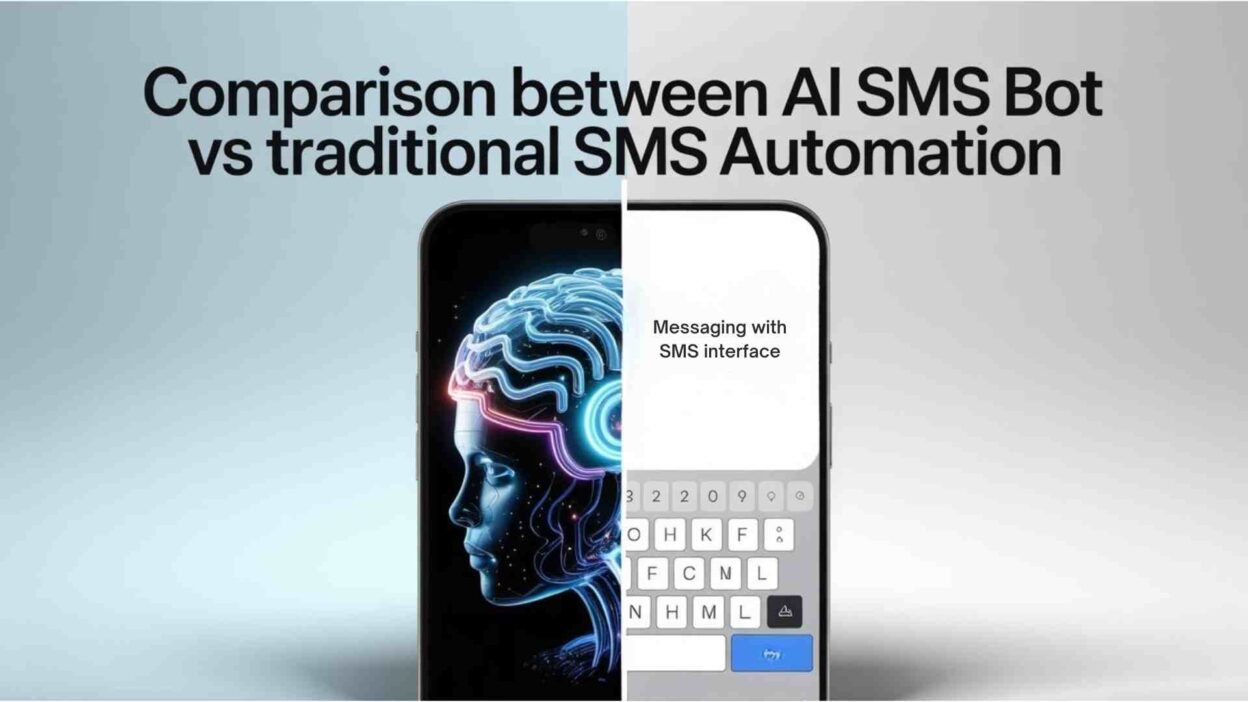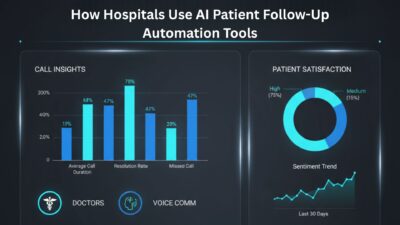TL;DR Text messages reach people instantly. They offer immediate engagement with customers. Businesses rely on SMS for communication. Two main technologies power SMS services today. Traditional SMS automation uses rule-based systems. Artificial intelligence SMS bots use advanced learning. Understanding the comparison between an AI SMS bot vs traditional SMS automation helps businesses choose wisely.
Table of Contents
Understanding SMS Automation Technologies
SMS automation changed business communication significantly. Companies no longer send messages manually. Automated systems handle thousands of texts daily. Two approaches dominate the market. Each has unique strengths and weaknesses. Learning about both options matters for business success.
What is Traditional SMS Automation
Traditional SMS automation uses predetermined rules and templates. A business creates specific message templates first. These templates trigger based on customer actions. Someone buys a product. An automatic message confirms the purchase. A customer abandons their shopping cart. A reminder message arrives automatically.
The comparison between an AI SMS bot vs traditional SMS automation starts with understanding how each works. Traditional systems follow if-then logic patterns. A customer signs up, send a welcome message. Someone makes a purchase, send a receipt. A customer reaches a certain spending level, then send a loyalty reward offer.
Rule-based systems offer simplicity and predictability. Businesses know exactly what messages they will send. They control the exact timing of communications. They can test different messages and measure results. These systems rarely surprise anyone with unexpected behavior.
Traditional SMS automation handles routine tasks exceptionally well. Appointment reminders work perfectly through automation. Delivery notifications are sent automatically without human input. Password resets trigger instantly when customers request them. Two-factor authentication codes arrive within seconds.
Setting up traditional systems requires less technical knowledge. Business users can create simple rules. They do not need programming expertise. They can modify messages without developer assistance. This accessibility makes traditional systems popular with small businesses.
However, traditional systems have limitations. They cannot understand customer context and cannot learn from interactions. Cannot adapt to new situations and follow scripts rigidly regardless of circumstances. A customer might receive irrelevant messages repeatedly. The system cannot recognize that the customer needs something different.
Traditional SMS automation also requires constant manual management. Businesses must create rules for every scenario. Unexpected situations break the system. New customer types may need new rules. Rule maintenance becomes a significant workload as businesses grow.
Introduction to AI SMS Bots
Artificial intelligence SMS bots represent a modern evolution. These systems use machine learning algorithms. They analyze customer behavior and preferences. They understand natural language inputs from customers. The comparison between AI SMS bot vs traditional SMS automation reveals significant technological differences.
AI SMS bots learn from every interaction. They study successful conversations and improve responses based on customer feedback. Adapt to changing customer needs. This learning capability makes AI systems increasingly effective over time.
Natural language processing gives AI bots exceptional flexibility. Customers can send text messages in their own words. The AI understands meaning even with typos or slang. It recognizes context and intent. It generates personalized responses without following rigid scripts.
AI SMS bots handle complex customer scenarios. A customer with a problem explains it naturally. The bot understands the issue and provides relevant help. It can ask clarifying questions, collects information needed to resolve problems and escalates issues to human agents.
Personalization represents another key strength of AI technology. These bots remember customer preferences and history. They customize messages based on individual preferences and suggest products that match customer interests. Time messages for maximum engagement. Customers feel like the business understands them personally.
AI SMS bots also provide predictive capabilities. They forecast customer needs before problems arise and identify upsell and cross-sell opportunities. Predict which customers might churn and recommend proactive retention strategies. This intelligence helps businesses stay ahead of customer needs.
However, AI systems require more sophisticated infrastructure. They need access to comprehensive customer data and require computing power to run machine learning models. Demand ongoing optimization and maintenance. Integrating AI with existing business systems can be complex.
Key Differences in AI SMS Bot vs Traditional SMS Automation
The comparison between an AI SMS bot vs traditional SMS automation reveals crucial distinctions. Understanding these differences helps businesses select appropriate solutions. Each technology excels in different situations. Matching technology to business needs ensures success.
Response Accuracy and Intelligence
Traditional SMS automation delivers consistent but limited responses. Messages follow predetermined templates. They cannot adapt to unusual situations. A customer asks an unexpected question. The system has no rule for this question. It sends a generic response or asks the customer to call.
AI SMS bots deliver contextually appropriate responses. They understand what customers actually need and provide relevant information and solutions. Recognize when issues are urgent and prioritize critical problems over routine inquiries. Customers receive helpful responses most of the time.
Accuracy improves continuously with AI systems. The more conversations the AI processes, the smarter it becomes. Patterns emerge in customer interactions. The AI learns what responses customers prefer. It adjusts its responses accordingly. Traditional systems remain static unless someone manually updates rules.
The comparison between an AI SMS bot vs traditional SMS automation shows different learning curves. Traditional systems start strong and improve only through manual intervention. AI systems start adequately and improve automatically. Given time, AI systems become significantly more accurate.
Customer satisfaction differs between technologies. Customers appreciate helpful, personalized responses. They become frustrated with irrelevant automatic messages. AI systems drive higher satisfaction scores. Traditional systems frustrate customers over time as limitations become apparent.
Learning Capabilities and Adaptation
Adaptation separates these technologies fundamentally. Traditional SMS automation cannot adapt automatically. Every scenario requires manual programming. Businesses struggle to keep up with changing customer needs. New market conditions demand new rules. Rule updates take time and resources.
AI SMS bots adapt automatically to changing circumstances. Seasonal variations trigger different responses automatically. New customer segments receive appropriate treatment. Market changes inform AI recommendations naturally. The system improves without human intervention.
The comparison between an AI SMS bot vs traditional SMS automation highlights this distinction clearly. Businesses using AI systems stay competitive naturally. Businesses using traditional systems must work constantly to stay current.
Personalization happens automatically with AI technology. The system learns individual customer preferences. It remembers purchase history and preferences. It customizes future communications accordingly. Each customer feels uniquely valued.
Traditional systems require manual personalization. Businesses must segment customers into groups. They must create different rules for each group. Manual segmentation never captures true individuality. Customers receive generic responses despite different needs.
User Experience Quality
Customer experience shapes business success fundamentally. AI SMS bots create superior user experiences. Customers enjoy conversational interactions. They feel understood by the system. Responses address their actual needs. Problems get resolved quickly and satisfactorily.
The comparison between an AI SMS bot vs traditional SMS automation shows significant UX differences. Traditional systems frustrate customers with irrelevant messages. Customers must wade through multiple irrelevant options. They might receive duplicate messages. The experience feels robotic and impersonal.
AI bots engage customers naturally. Conversations feel human-like despite machine interactions. Customers can ask questions in their own words. They get personalized recommendations. They receive proactive help before problems escalate. The experience feels smooth and intuitive.
Response time differs between systems, too. Traditional automation delivers instant responses but only for programmed scenarios. AI systems also respond quickly but with more relevant content. Customers prefer AI responses because they address actual concerns.
Efficiency matters from the customer perspective. Customers value quick problem resolution. AI bots solve problems faster than traditional systems. Fewer escalations to human agents occur. Customers spend less time seeking help. Satisfaction scores increase measurably.
Performance Metrics: AI SMS Bot vs Traditional SMS Automation
Businesses must evaluate technology performance objectively. The comparison between an AI SMS bot vs traditional SMS automation requires examining concrete metrics. Numbers reveal which approach delivers better results.
Speed and Efficiency Comparisons
Both systems deliver messages quickly. Traditional SMS automation sends predetermined messages instantly. AI SMS bots also send messages within seconds. Message delivery speed does not differentiate these technologies.
Response quality distinguishes them significantly. Traditional systems deliver responses instantly but often irrelevantly. The customer must read irrelevant options and figure out what they need. This takes additional customer time. The process feels inefficient despite instant message delivery.
AI SMS bots deliver relevant responses instantly. Customers understand the answer immediately. They can take action right away. No confusion or wasted time occurs. The process feels genuinely efficient.
Operational efficiency differs substantially. Traditional systems require significant manual management. Staff must monitor performance constantly. They must adjust the rules when problems arise. They must create new rules for new situations. Significant human effort maintains the system.
AI SMS bots require less ongoing manual intervention. The system improves itself automatically. Staff focuses on strategy rather than mechanics. Fewer rule adjustments become necessary. Operational workload decreases significantly.
The comparison between an AI SMS bot vs traditional SMS automation reveals efficiency gains with AI. Overall resource consumption decreases. Employees focus on higher-value activities. Business productivity increases noticeably.
Cost Analysis
Initial investment differs significantly between approaches. Traditional SMS automation costs less to implement. No specialized expertise is required. Setup takes minimal time. Businesses can launch quickly and inexpensively.
AI SMS bots require a larger upfront investment. They demand technical expertise to implement. Integration with existing systems takes longer. Training staff on new tools requires time. Initial setup costs substantially more.
Long-term costs tell a different story. Traditional systems require ongoing maintenance costs. Rules need constant updates. New scenarios demand new rule creation. Staff time accumulates significantly. Operating costs remain high.
AI SMS bots have higher initial costs but lower ongoing costs. Maintenance needs decrease after initial setup. The system improves automatically without staff intervention. Operating costs decrease over time. Cost per interaction drops significantly.
The comparison between an AI SMS bot vs traditional SMS automation shows different cost patterns. Traditional systems suit short-term use. AI systems make sense for long-term implementation. Businesses planning to use SMS for years benefit from AI investment.
ROI calculations favor different systems for different situations. Low-volume businesses might prefer traditional systems. High-volume businesses benefit from AI systems. Seasonal businesses might choose differently from year-round operations.
Scalability Potential
Traditional SMS automation scales reasonably well. Additional messages simply add to existing systems. Infrastructure can handle increasing volumes. However, rule management becomes unwieldy at scale. Hundreds of rules become difficult to maintain. Rule conflicts and duplications arise naturally.
AI SMS bots scale elegantly. Increased volume does not complicate system management. The AI handles complex scenarios as easily as simple ones. Performance remains consistent regardless of volume. The system learns from increased interactions. Accuracy improves with scale.
The comparison between an AI SMS bot vs traditional SMS automation highlights scaling differences. Traditional systems reach practical limits eventually. Businesses must migrate to AI eventually if they grow. AI systems accommodate growth naturally.
Business growth patterns affect technology choice. Small businesses with stable customer bases fit traditional systems. Growing businesses should invest in AI. Rapidly expanding businesses must use AI to succeed.
Real-World Applications of AI SMS Bot vs Traditional SMS Automation
Both technologies solve real business problems. Specific applications suit each technology. Understanding appropriate use cases matters significantly.
Customer Service Implementations
Customer support represents a major SMS use case. Businesses answer customer questions via SMS. They handle complaints and resolve issues. They provide order status updates.
Traditional SMS automation works for routine queries. Customers ask simple questions. Predefined responses answer most inquiries. Appointment reminders are sent automatically. Delivery notifications trigger without staff involvement.
However, complex issues challenge traditional systems. Customers describe problems requiring analysis. They need customized solutions. They expect empathetic responses. Traditional systems cannot provide this.
The comparison between an AI SMS bot vs traditional SMS automation favors AI for complex support. AI bots understand customer problems deeply. They ask clarifying questions and provide customized solutions. They escalate complex issues to human agents appropriately. Customer satisfaction increases.
Many businesses use hybrid approaches. Simple questions go to traditional automation. Complex issues go to AI bots or human agents. This strategy optimizes cost and quality.
Marketing and Outreach Uses
Marketing uses SMS for promotional campaigns. Businesses send offers and announcements. They drive traffic to stores and websites. They build customer loyalty.
Traditional SMS automation handles bulk promotions well. Businesses send the same message to large groups. They schedule messages for optimal timing. They measure response rates easily. Campaigns track performance simply.
However, personalization suffers with traditional systems. The same message reaches everyone. Customers with different preferences receive identical offers. Some messages irritate customers. Unsubscribe rates climb when campaigns lack relevance.
AI SMS bots personalize marketing. They send offers matching individual preferences and avoid suggesting products that customers have already bought. Recommend complementary products and time messages based on customer behavior patterns.
The comparison between an AI SMS bot vs traditional SMS automation shows AI superiority for sophisticated marketing. Conversion rates improve with personalization. Customer retention increases. Marketing ROI climbs noticeably.
Business Operations Benefits
Internal business communications also use SMS. Staff receive alerts about critical issues. Managers get notifications about important events. Teams coordinate activities via SMS.
Traditional SMS automation handles notifications effectively. System alerts trigger automatically when problems arise. Staff receive immediate notification of critical issues. Response time improves dramatically. Downtime decreases significantly.
AI SMS bots enhance operational benefits further. They determine alert priority and route notifications to appropriate personnel. Provide context about problems and suggest solutions.
The comparison between an AI SMS bot vs traditional SMS automation shows both deliver operational value. Traditional systems excel for straightforward alerts. AI systems excel in complex situations. Many businesses use both technologies together.
Advantages and Limitations
Each technology has clear strengths and clear limitations. Honest evaluation matters when choosing between them.
AI SMS Bot Strengths and Weaknesses
AI SMS bots deliver numerous advantages. They provide personalized customer experiences and understand context and intent naturally. Learn and improve continuously and handle complex situations easily. Reduce the workload for staff and deliver superior customer satisfaction.
However, AI bots have limitations. They require significant initial investment. Technical integration can be complex. Specialized expertise may be necessary. Data privacy considerations arise with AI. Some customers distrust AI systems initially.
Traditional SMS Automation Strengths and Weaknesses
Traditional systems offer clear advantages. Implementation costs remain low. Setup happens quickly without specialized expertise. Systems remain predictable and controllable. Simple scenarios resolve instantly. Reliability proves consistent.
Yet traditional systems have serious limitations. They cannot adapt to new situations and provide impersonal customer experiences. Frustrate customers with irrelevant messages and require constant manual management. Do not improve automatically and cannot handle complex interactions.
The comparison between an AI SMS bot vs traditional SMS automation ultimately depends on business needs. Small businesses valuing simplicity choose traditional systems. Growth-focused businesses choose AI. Many businesses use both technologies strategically.
Frequently Asked Questions
Which technology costs less initially?
Traditional SMS automation costs substantially less to implement initially. Businesses can launch simple systems within days. No specialized technical expertise is required. Setup involves basic configuration only. AI SMS bots require larger upfront investments. They demand technical expertise for integration. Initial setup takes weeks rather than days. The comparison between an AI SMS bot vs traditional SMS automation clearly favors traditional systems for initial cost.
Are AI bots completely autonomous?
AI SMS bots operate semi-autonomously. They handle routine situations completely independently. Complex issues escalate to human agents. Businesses maintain control through monitoring. They can override AI decisions when necessary. They review and approve policy changes. AI works best alongside human staff. This hybrid approach combines AI efficiency with human judgment.
Can businesses switch from traditional to AI systems easily?
Migration from traditional to AI systems is achievable. Customer data transfers relatively easily. Historical rules inform AI training. Integration points map from traditional systems to AI platforms. However, migration takes time and effort. Staff require training on new systems. Some downtime might occur during the transition. Planning the migration carefully minimizes disruption. The comparison between an AI SMS bot vs traditional SMS automation makes migration worthwhile for growing businesses.
Read More: Can Startups Grow Faster with an Affordable AI SMS Bot?
Conclusion

Business success depends on choosing the right tools. SMS communication has become essential for customer engagement. The choice between technologies matters significantly. The comparison between an AI SMS bot vs traditional SMS automation requires an honest evaluation of business needs. Small businesses with simple needs benefit from traditional systems. Implementation happens quickly and cheaply. Operations remain straightforward and predictable. Costs stay minimal. These businesses achieve their SMS goals efficiently.
Growing businesses should seriously consider AI systems. Traditional systems eventually limit growth. Scaling traditional systems becomes difficult. Rule management becomes overwhelming. Customer experience suffers. AI systems grow with the business naturally. The comparison between an AI SMS bot vs traditional SMS automation shows each technology has merit. Neither approach is universally superior. Context matters enormously. Business size, growth expectations, customer complexity, and budget all influence the right choice.
Hybrid approaches often work best. Businesses deploy traditional automation for simple, routine tasks. They deploy AI bots for complex customer interactions. This combination optimizes cost and performance. Routine operations stay simple and cheap. Complex situations receive intelligent handling. Technology continues to advance rapidly. AI capabilities improve constantly. Traditional systems remain relatively static. Businesses choosing AI today invest in future-ready solutions. They position themselves advantageously as technology evolves.
The comparison between an AI SMS bot vs traditional SMS automation ultimately depends on vision. What does the business want to achieve? How will the business grow? What customer experience should it deliver? Answering these questions guides technology selection. Successful businesses evaluate options carefully. They pilot technologies before full commitment and monitor performance metrics continuously. Adjust strategies based on results and remain open to evolving their approach.






[…] Read More: Comparison Between AI SMS Bot vs Traditional SMS Automation […]